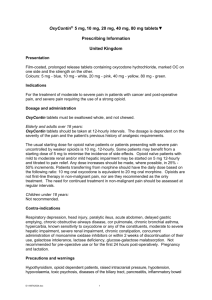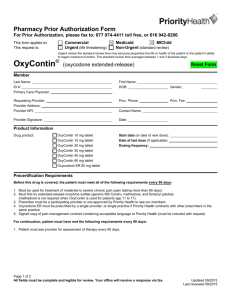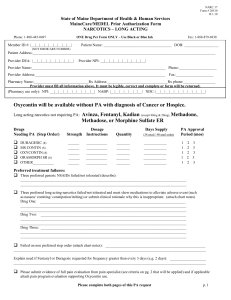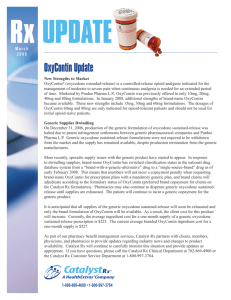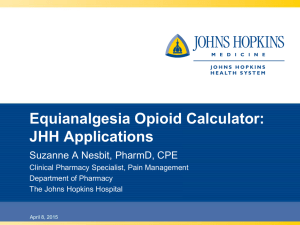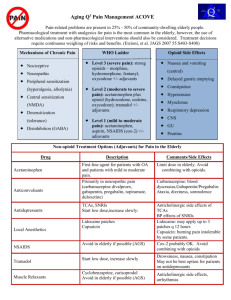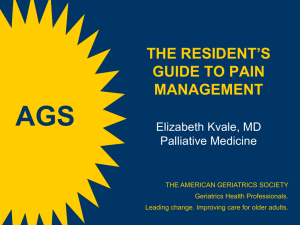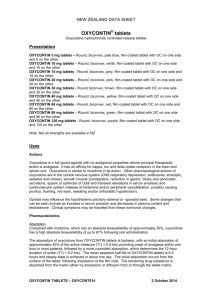OXYCODONE HCL CONTROLLED
advertisement
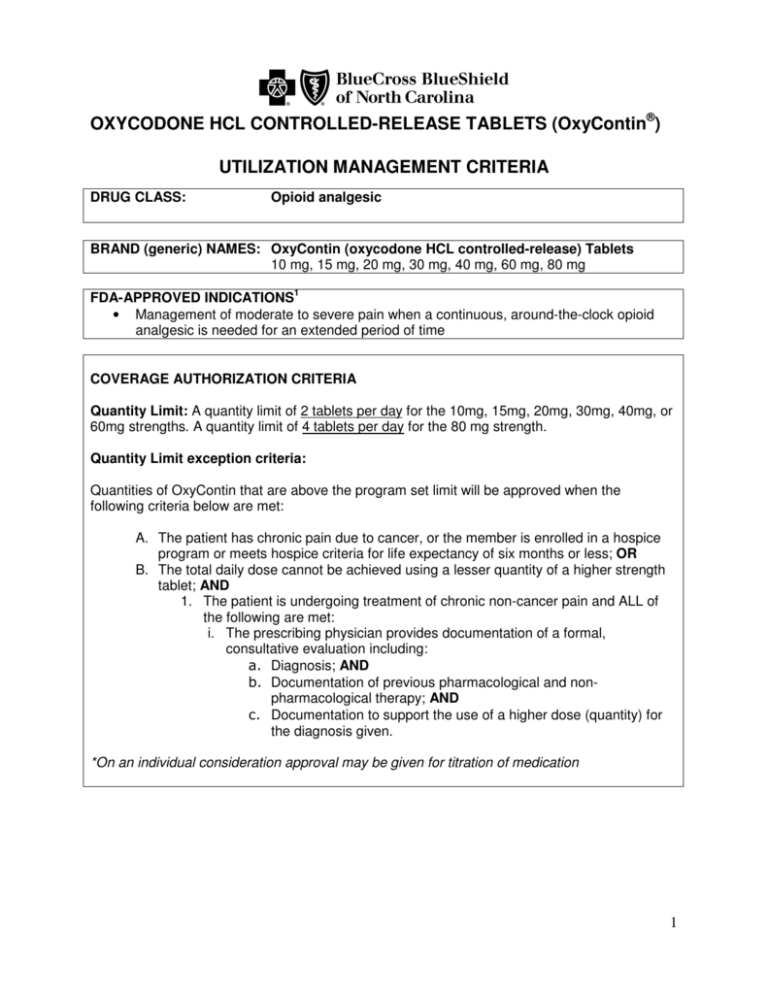
OXYCODONE HCL CONTROLLED-RELEASE TABLETS (OxyContin®) UTILIZATION MANAGEMENT CRITERIA DRUG CLASS: Opioid analgesic BRAND (generic) NAMES: OxyContin (oxycodone HCL controlled-release) Tablets 10 mg, 15 mg, 20 mg, 30 mg, 40 mg, 60 mg, 80 mg FDA-APPROVED INDICATIONS1 • Management of moderate to severe pain when a continuous, around-the-clock opioid analgesic is needed for an extended period of time COVERAGE AUTHORIZATION CRITERIA Quantity Limit: A quantity limit of 2 tablets per day for the 10mg, 15mg, 20mg, 30mg, 40mg, or 60mg strengths. A quantity limit of 4 tablets per day for the 80 mg strength. Quantity Limit exception criteria: Quantities of OxyContin that are above the program set limit will be approved when the following criteria below are met: A. The patient has chronic pain due to cancer, or the member is enrolled in a hospice program or meets hospice criteria for life expectancy of six months or less; OR B. The total daily dose cannot be achieved using a lesser quantity of a higher strength tablet; AND 1. The patient is undergoing treatment of chronic non-cancer pain and ALL of the following are met: i. The prescribing physician provides documentation of a formal, consultative evaluation including: Diagnosis; AND Documentation of previous pharmacological and nonpharmacological therapy; AND Documentation to support the use of a higher dose (quantity) for the diagnosis given. *On an individual consideration approval may be given for titration of medication 1 WARNINGS AND PRECAUTIONS: BLACK BOX WARNING WARNING: IMPORTANCE OF PROPER PATIENT SELECTION AND POTENTIAL FOR ABUSE OxyContin contains oxycodone which is an opioid agonist and a Schedule II controlled substance with an abuse liability similar to morphine. OxyContin can be abused in a manner similar to other opioid agonists, legal or illicit. This should be considered when prescribing or dispensing OxyContin in situations where the physician or pharmacist is concerned about an increased risk of misuse, abuse, or diversion. OxyContin is a controlled-release oral formulation of oxycodone hydrochloride indicated for the management of moderate to severe pain when a continuous, around-the-clock opioid analgesic is needed for an extended period of time. OxyContin is not intended for use on an as-needed basis. Patients considered opioid tolerant are those who are taking at least 60 mg oral morphine/day, 25 mcg transdermal fentanyl/hour, 30 mg oral oxycodone/day, 8 mg oral hydromorphone/day, 25 mg oral oxymorphone/day, or an equianalgesic dose of another opioid for one week or longer. OxyContin 60 mg and 80 mg tablets, a single dose greater than 40 mg, or a total daily dose greater than 80 mg are only for use in opioid-tolerant patients, as they may cause fatal respiratory depression when administered to patients who are not tolerant to the respiratorydepressant or sedating effects of opioids. Persons at increased risk for opioid abuse include those with a personal or family history of substance abuse (including drug or alcohol abuse or addiction) or mental illness (e.g., major depression). Patients should be assessed for their clinical risks for opioid abuse or addiction prior to being prescribed opioids. All patients receiving opioids should be routinely monitored for signs of misuse, abuse and addiction. OxyContin must be swallowed whole and must not be cut, broken, chewed, crushed, or dissolved. Taking cut, broken, chewed, crushed or dissolved OxyContin tablets leads to rapid release and absorption of a potentially fatal dose of oxycodone. The concomitant use of OxyContin with all cytochrome P450 3A4 inhibitors such as macrolide antibiotics (e.g., erythromycin), azole-antifungal agents (e.g., ketoconazole), and protease inhibitors (e.g., ritonavir) may result in an increase in oxycodone plasma concentrations, which could increase or prolong adverse effects and may cause potentially fatal respiratory depression. Patients receiving OxyContin and a CYP3A4 inhibitor should be carefully monitored for an extended period of time and dosage adjustments should be made if warranted. Other Warnings and Precautions: • • Respiratory depression CNS depression 2 • Hypotensive effects • Drug abuse, addiction, and dependence • Paralytic ileus • Seizures *Please see package insert for more extensive list DOSAGE AND ADMINISTRATION: OxyContin tablets must be swallowed whole and must not be cut, broken, chewed, crushed or dissolved. Taking cut, broken, chewed, crushed or dissolved OxyContin tablets leads to rapid release and absorption of a potentially fatal dose of oxycodone. Individually titrate OxyContin to a dose that provides adequate analgesia and minimizes adverse reactions while maintaining an every-twelve-hour dosing regimen. OxyContin 60 mg and 80 mg Tablets, a single dose greater than 40 mg, or a total daily dose greater than 80 mg are only for use in opioid-tolerant patients. Use of these doses in patients who are not opioid tolerant may cause fatal respiratory depression. REFERENCES: 1. OxyContin. (oxycodone hydrochloride controlled-release). Purdue Pharma, L.P., Stamford, CT. November 2011 2. Chou, R., Fanciullo, G.J, et al. (The American Pain Society–American Academy Of Pain Medicine Opioids Guidelines Panel). Opioid Treatment Guidelines: Clinical Guidelines for the Use of Chronic Opioid Therapy in Chronic Noncancer Pain. The Journal of Pain, Vol 10, No 2 (February), 2009: pp 113-130 3
